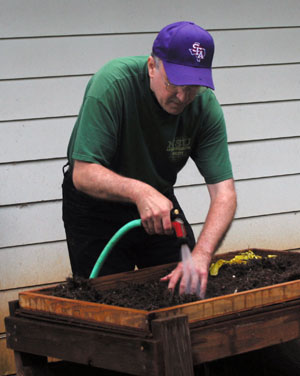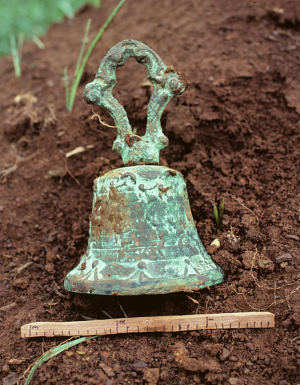George Avery and Steve Black are the primary authors of this exhibit. Additional writing was contributed by Mark Wolf, Sandra Calpakis, and Jeff Williams. Photographs were taken by Avery, Alfred Broden, Andrea Locke, and John Teichgraeber. Computer graphics were created by Jeff Williams. Black put together the exhibit. Web development was done by Black, Jay Parteek, and Jason Glisson of Texas State University. Patricia Christmas proofread the final exhibit.
This exhibit was underwritten by the National Park Service Challenge Cost Share Program and Stephen F. Austin University.
George Avery is the Cultural Heritage Resource Coordinator at Stephen F. Austin State University in Nacogdoches, Texas. He received his Ph.D. from the University of Florida where his research focused on Spanish olive jar production during the Spanish Colonial period. Avery served as Los Adaes Station Archaeologist for the Louisiana Division of Archaeology between 1995 and 2005 based out of Northwestern State University in Natchitoches, Louisiana.
Steve Black is the Texas State Editor of this website and Assistant Professor of Anthropology at Texas State University, San Marcos.
Alfred L. Broden, Director of the Mission Dolores Visitors Center and Museum, has been truly phenomenal in his support of the research projects at the mission. Assisting in every aspect of the projects, from excavating shovel tests, to water screening and sorting in the lab, Al has been there every step of the way and contributed numerous photos to this exhibit.
Sandra Calpakis, born and raised in San Augustine, Texas, and long time member of the San Augustine County Historical Society, has conducted research covering a variety of subjects related to the history of the area surrounding San Augustine. Her research on the Ais Indians over the last ten years has uncovered information not found in secondary sources related to the Ais.
Andrea Locke and John Teichgraeber were both interns in the SFA Archaeology Lab during the fall 2008 semester. Teichgraeber graduated in December, 2008 and Locke graduates in August, 2010.
Jeff Williams is the GIS systems administer for the College of Forestry and Agriculture at Stephen F.Austin. He was one of Corbin's students and has specialized in documenting surviving traces of El Camino Real de los Tejas. He also assisted in the 2008 investigations at Mission Dolores.
Mark Wolf is a San Antonio based architect who is well known within the historical community for his work on the Mission Santa Cruz de San Sabá project. He spearheaded the efforts to find the Mission, and is a direct lineal descendant of Juan Leal—one of the survivors of the 1758 massacre at Mission San Sabá. With Mission Dolores, Mark Wolf is leading the effort to design a replica of the 18th-century jacal structures that would have been present.
For additional information about this exhibit please contact George Avery at Stephen F. Austin State University: averyg@sfasu.edu.
Links:
El Camino Real de los Tejas National Historic Trail. National Park Service.
Life at an Eighteenth-Century Spanish Outpost. Louisiana Division of Archaeology, Office of Cultural Development, Department of Culture, Recreation, and Tourism, Office of the Lieutenant Governor.
Los Adaes: Eighteen-Century Capital of Spanish Texas. Texas Beyond History, University of Texas, Austin.
Nuestra Señora de los Dolores de los Ais Mission. The Handbook of Texas Online, Texas State Historical Association.
Old San Antonio Road. The Handbook of Texas Online, Texas State Historical Association.
Pagès, Pierre Marie François de. The Handbook of Texas Online, Texas State Historical Association.
Print Sources:
All sources with the Adobe Acrobat symbol— —can be downloaded as PDF files. —can be downloaded as PDF files.
Avery, George, editor
2007 French Colonial Pottery: An International Conference. Northwestern State University Press, Natchitoches, Louisiana.
Berlandier, Jean Louis
1969 The Indians of Texas in 1830. Edited and Introduced by John C. Ewers. Smithsonian Institution Press, Washington, D.C.
Carlson, Shawn Bonath and Kendra L. Quinn
1996 Archaeological Investigations at Mission Dolores de los Ais (41SA25) 1995-96, San Augustine County, Texas. Technical Report No. 1, Historic Sites Research, College Station, Texas. Download 
Carter, Cecile Elkins
1995 Caddo Indians: Where we Come From. University of Oklahoma Press, Norman.
Corbin, James E.
1977 Archeological Research at 41SA25, Mission Dolores de los Ais 1977, A Preliminary Report submitted to the Texas Historical Commission .Stephen F. Austin State University, Nacogdoches, Texas. Download 
1989 Spanish-Indian Interaction on the Eastern Frontier of Texas, in David Hurst Thomas, editor, Columbian Consequences, Volume 1: Archaeological and Historical Perspectives on the Spanish Borderlands West, pages 269-276. Smithsonian Institution Press, Washington, D.C.
1991 Retracing the Camino Real de los Tejas from the Trinity river to Los Adaes: New Insights into East Texas History. In A. Joachim McGraw, John W. Clark, and Elizabeth A. Robbins, editors, A Texas Legacy: The Old San Antonio Road and the Caminos Reales, A Tricentennial History, 1691-1991, pages 191-223. Texas Department of Highways and Public Transportation, Austin, Texas.
2007 Cultural Diversity in the Southern Caddo Region. Journal of Northeast Texas Archaeology 26:11-23.
Corbin, James E., Thomas C. Alex, and Arlan Kalina
1980 Mission Dolores de los Ais. Papers in Anthropology 2. Stephen F. Austin State University, Nacogdoches, Texas. Download 
Corbin, James E.; Heather A. Brown, Mary G. Canavan, and Sharon Toups
1990 Mission Dolores de los Ais (41SA25) San Augustine County, Texas. Texas State Department of Highways and Public Transportation, Highway Design Division, Stephen F. Austin State University, Papers in Anthropology, No. 5, Nacogdoches, Texas. Download 
Crocket, George Louis
1932 Two Centuries in East Texas: A History of San Augustine County and Surrounding Territory from 1685 to the Present time. The Southwest Press, Dallas, Texas.
Deagan, Kathleen
1987 Artifacts of the Spanish Colonies of Florida and the Caribbean, 1500-1800. Volume 1: Ceramics, Glassware and Beads. Smithsonian Institution Press, Washington, D.C.
2002 Artifacts of the Spanish Colonies of Florida and the Caribbean, 1500-1800. Volume 2: Portable Personal Possessions. Smithsonian Institution Press, Washington, D.C.
Farley, James A., W. Fredrick Limp, and Jami Lockhart
1990 The Archaeologist's Workbench: Integrating GIS, Remote Sensing, EDA, and Database Management. In Interpreting Space: GIS and Archaeology. Edited by Kathleen M. S. Allen, Stanton W. Green, and Ezra B. W. Zubrow, pp. 141-164. Taylor & Francis, London.
Fletcher, Alice C.
1907 “Caddo.” Bulletin of the Bureau of American Ethnology 30:179-82.
Foster, William C.
1995 Spanish Expeditions into Texas, 1689-1768. University of Texas Press, Austin.
Gao, Jay
2002 Integration of GPS with Remote Sensing and GIS: Reality and Prospect. In Photogrammetric Engineering and Remote Sensing 68(5):447-453, edited by James W. Merchant, Kimberly A. Tilley, and James B. Case. American Society of Photogrammetry and Remote Sensing, Bethesda.
Gilmore, Kathleen
1980 Mission Dolores de los Ais, Historical Background and Field Investigations, 1972-73, by Kathleen Gilmore. Appendix I, in Corbin, James E.; Thomas C. Alex, and Arlan Kalina, Mission Dolores de los Ais. Papers in Anthropology No. 2, Stephen F. Austin State University, Nacogdoches, Texas.
Jelks, Edward B.
1962 Investigation of the Alleged Site of Nuestra Señora de los Dolores del los Ais, San Augustine, Texas. Unpublished letter report on file, Texas Archeological Research Laboratory, University of Texas at Austin. Download 
LaVere, David
1998 The Caddo Chiefdoms. Caddo Economics and Politics, 700-1835. University of Nebraska Press, Lincoln.
Lemée, Patricia R.
1998 Tíos and Tantes: Familial and Political Relationships of Natchitoches and the Spanish Colonial Frontier. Southwestern Historical Quarterly 101(3):341-350.
McGraw, A. Joachim McGraw, John W. Clark, and Elizabeth A. Robbins
1991 A Texas Legacy: The Old San Antonio Road and the Caminos Reales, A Tricentennial History, 1691-1991. Texas Department of Highways and Public Transportation, Austin, Texas.
Middlebrook, Tom
2007 A Survey of Historic Caddo Sites in Nacogdoches County, Texas. Journal of Northeast Texas Archaeology 26:99-115.
Naylor, Thomas H. and Charles W. Polzer, S.J.
1988 Pedro de Rivera and the Military Regulations for Northern New Spain, 1724-1729. A Documentary History of His Frontier Inspection and The Reglamento de 1729. The University of Arizona Press, Tucson.
Newcomb, W.W., Jr.
1961 The Indians of Texas: From Prehistoric to Modern Times. University of Texas Press, Austin.
Oglesbee, John and Betty
2001 San Augustine: A Texas Treasure. Ann and Lee Lawrence East Texas History Series, Volume No. 5, East Texas Historical Association, Nacogdoches, Texas.
Pagés, Pierre Marie François de
1793 Travels Round the World in the Years 1767, 1768, 1769, 1770, 1771. Translated from the French, second edition, corrected and enlarged, volume 1, J. Murray, London.
Noël Hume, Ivor
1991 A Guide to Artifacts of Colonial America. Vintage Books, New York.
Padilla, Juan Antonio
1919 Texas in 1820. Report of the Barbarous Indians of the Province of Texas. Translated by Mattie Austin Hatcher. Southwestern Historical Quarterly, vol. 23, no. 1, pp. 47-68.
Perttula, Timothy K.
1992 “The Caddo Nation”: Archaeological and Ethnohistoric Perspectives. University of Texas Press, Austin.
Sibley, John
1806 Historical Sketches of the Several Indian Tribes in Louisiana. American State Papers, Class II, Indian Affairs 1:721-31.
1922 Indian Notes and Monographs. A Report from Natchitoches in 1807. Edited, with an Introduction, by Annie Heloise Abel. Museum of the American Indian, Heye Foundation, New York.
Smith, F. Todd
1995 The Caddo Indians. Tribes at the convergence of Empires, 1542-1854. Texas A&M University Press, College Station.
Solís, Fray Gaspar José de
1931 Diary of a Visit of the Texas Missions Made by Fray Gaspar José de Solís in the Year 1767-68. Translated by Margaret Kenney Kress with Introductory Note by Mattie Austin Hatcher. Southwestern Historical Quarterly 35:28-76.
Swanton, John R. Swanton
1996 Source Material on the History and Ethnology of the Caddo Indians. Reprint of 1942 edition. University of Oklahoma Press, Norman.
Williams, Jeffrey M.
2007 GIS Aided Archaeological Research of El Camino Real de los Tejas with Focus on Landscape and River Crossings along El Camino Carretera. Master’s Thesis, Stephen F. Austin State University, Nacogdoches, Texas. Available online.
|

Author George Avery water screening sediment from Mission Dolores excavations. |
|
Visit Mission Dolores!
The modern day visitor to Mission Dolores will find a museum, visitor’s center, walking trail, archaeology lab, and recreational vehicle park. The museum is open Monday through Saturday from
9 am to 4 pm and includes an introductory video, numerous panel exhibits, and examples of a wide variety of the artifacts recovered during the archaeological investigations. The walking trail makes a loop from the Visitor’s Center to the RV Park, and passes through Mission Hill on the way.
Links with information about what to do in San Augustine:
www.sanaugustinetx.com
|

This small brass or copper bell was photographed by Jim Corbin during the 1977 excavations at Mission Dolores. Unfortunately, there is nothing in the site records to suggest that it was found during his work. Avery suspects that the bell was brought to the site by an area resident as a "show and tell" item. Over the decades many mission-era artifacts have been collected from the site, particularly during the early 20th century when Highway 147 was built right through it. But the original and current provenience of this artifact remains unknown.
Perhaps you can help tell its tale? SFA Archaeology Laboratory.  |
|
 —can be downloaded as PDF files.
—can be downloaded as PDF files.
